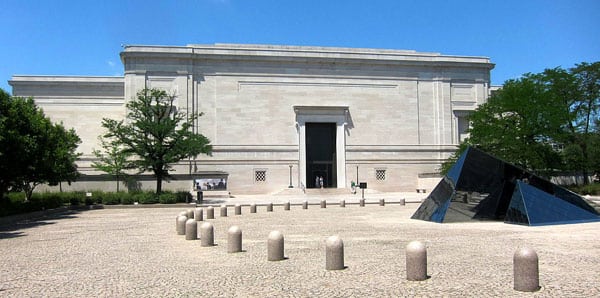
August 29, 2018; Washington Post
Earl “Rusty” Powell III, who has directed the National Gallery of Art in Washington, DC for 26 years, is retiring. This, notes Peggy McGlone, gives the museum an “opportunity to revitalize its programs.”
The National Gallery consists of two buildings—the West Building and the East Building, which are connected underground—and a sculpture garden. The Gallery owns roughly 150,000 works of primarily American and European art. It has a $190 million budget, 75 percent funded by taxpayers, employs 1,100 people, and is seen by about five million visitors a year.
In her Washington Post article, McGlone reports on interviews she conducted with 22 current and former employees and industry experts. “The search for the next director of the National Gallery of Art has revealed deep divisions,” McGlone writes, and has surfaced “staff claims of widespread mismanagement.” The transition provides the museum with an opportunity to right the ship—or to fail to do so.
Kym Rice, assistant director for academic affairs at the Corcoran School of the Arts and Design at George Washington University, notes the potential for a new leader can revitalize an institution, pointing to the hiring of Melissa Chiu at the Hirshhorn Museum and Sculpture Garden in 2014, another Smithsonian museum, as an example. McGlone writes that Chiu has been a successful fundraiser “and presented highly acclaimed exhibitions that have attracted a younger audience.”
In terms of the National Gallery, its challenges include:
Sign up for our free newsletters
Subscribe to NPQ's newsletters to have our top stories delivered directly to your inbox.
By signing up, you agree to our privacy policy and terms of use, and to receive messages from NPQ and our partners.
- Increasing its web traffic: The National Gallery had 8.2 million web visitors last year. By comparison, New York’s Metropolitan Museum of Art (Met) had 38.3 million web visitors, New York’s Museum of Modern Art (MoMA) 27.7 million web visitors, and the Getty Museum in Los Angeles had 14.7 million web visitors.
- Raising its social media presence: The National Gallery has about 1.3 million followers on Instagram, Facebook and Twitter. This is much less than the 11 million followers reached by (MoMA) or the 8.8 million obtained by the Met.
- Boosting staff morale: McGlone says the staff that she interviewed report, “Poor management across multiple departments has caused high turnover and low staff morale.”
- Ending sexual harassment and favoritism: According to McGlone, seven current and former employees informed her of “long-standing problems of sexual harassment, retaliation and favoritism.”
- Improving the museum’s grievance process: McGlone notes that several workers described to her their struggles with supervisors and staff assigned to review their complaints. “Employees,” McGlone writes, “describe a top-down work environment that ignores complaints by prematurely closing investigations.”
McGlone also discloses that there is a lot of speculation as to who will succeed Powell. According to McGlone, the smart money says an inside candidate, C. D. Dickerson, curator and head of the department of sculpture and decorative arts at the National Gallery and widely viewed as a Powell protégé, is the most likely successor. Of course, staff speculation in the middle of a hiring process has erred before. Clearly, as the number of sources in McGlone’s article demonstrates, there is considerable resistance to going this route. It is expected that a choice will be made in the next month or two.
“There’s a moment for reinvention,” notes Gail Anderson, a museum consultant, about the opportunity posed by filling the position long held by a veteran leader. “How do you change the culture of an institution, its position in the community? You have this moment to pivot.”
Some, such as Rice, have advocated for the museum to hire either a woman and/or a person of color to be the next museum director. As McGlone notes, “In the National Gallery’s 77-year history, four white men have been directors.” Rice tells McGlone that “it would be great if they hired a woman. It would be breaking the glass ceiling and be really inspiring to other museums.”
As Robin Pogrebin in the New York Times wrote earlier this month, “a growing number of museums are addressing diversity with new urgency.” As NPQ has reported, art has long been a white-dominated field. A 2015 study published by the Andrew W. Mellon Foundation found that 84 percent of art museum curators were white (compared to 62 percent in the US population).
“There’s change coming. Who is going to set you up for the next 10 years? Who is out there who can really connect with our public?” These are the kind of questions, says Sree Sreenivasan, a social media consultant who used to work for the Met, that should inform the National Gallery’s hiring process.
As McGlone notes, whoever is hired will inherent many challenges. “The next leader of Washington’s premier art museum takes the helm at a time of major change in the cultural world. Museums, even ones that have significant government support, are complex organizations that require fundraising prowess, artful management, and a vision for the future. Executives must navigate changing visitor tastes and increased competition for their attention, while simultaneously preserving an institution’s mission and engaging its strongest supporters.”—Steve Dubb













